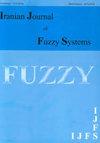Hybrid data compression using fuzzy logic and Huffman coding in secure IOT
IF 1.2
4区 数学
Q1 MATHEMATICS
引用次数: 1
Abstract
Research in the area of Internet of things (IoT) and cloud computing has gained a considerable attention in today's world of information technology (IT). Data compression and security are increasingly appreciated due to their imperative roles in online data sharing and transfer in multimedia networks. Hence, image compression is focused on reducing data redundancy and saving memory and transmission bandwidth. Because of the increased entropy of coded images, it is difficult to reduce the amount of lossless information after encryption using the existing methods. Accordingly, using the hybrid Huffman coding algorithm, it is possible to guarantee the security and verification of information. Therefore, an efficient compression method is proposed that combines fuzzy logic with Huffman coding. In this method, coding is based on Hoffman code, which is statistically independent and defines fuzzy logic-based weighting functions for the frequency of the existing symbols in data to generate efficient code for compression. Fuzzy logic is then coded to provide a secure information mapping on the information codes. In this proposed system, the key information is coded using the special key of that information and the data is embedded using the data encryption key and data in the receiver are decoded using the same key. Here, different compression techniques are compared with Huffman coding. The simulation is performed under matlab2017b software. The results show that a good compression rate is achieved, there is no significant difference between the decoded and original images and compression ratio in the image is increased to over 40%.安全物联网中使用模糊逻辑和霍夫曼编码的混合数据压缩
物联网(IoT)和云计算领域的研究在当今的信息技术(IT)领域获得了相当大的关注。由于数据压缩和安全在多媒体网络中在线数据共享和传输中的重要作用,它们越来越受到人们的重视。因此,图像压缩的重点是减少数据冗余,节省内存和传输带宽。由于编码图像的熵增加,现有的方法很难减少加密后的无损信息量。因此,采用混合霍夫曼编码算法,可以保证信息的安全性和可验证性。为此,提出了一种将模糊逻辑与霍夫曼编码相结合的高效压缩方法。在该方法中,编码基于霍夫曼码,霍夫曼码具有统计独立性,并为数据中现有符号的频率定义基于模糊逻辑的权重函数,以生成高效的编码进行压缩。然后对模糊逻辑进行编码,以在信息代码上提供安全的信息映射。在该系统中,密钥信息使用该信息的特殊密钥进行编码,数据使用数据加密密钥嵌入,接收端的数据使用相同的密钥进行解码。在这里,不同的压缩技术与霍夫曼编码进行了比较。仿真在matlab2017b软件下进行。结果表明,该方法获得了较好的压缩率,解码后的图像与原始图像没有明显差异,图像压缩比提高到40%以上。
本文章由计算机程序翻译,如有差异,请以英文原文为准。
求助全文
约1分钟内获得全文
求助全文
来源期刊
CiteScore
3.50
自引率
16.70%
发文量
0
期刊介绍:
The two-monthly Iranian Journal of Fuzzy Systems (IJFS) aims to provide an international forum for refereed original research works in the theory and applications of fuzzy sets and systems in the areas of foundations, pure mathematics, artificial intelligence, control, robotics, data analysis, data mining, decision making, finance and management, information systems, operations research, pattern recognition and image processing, soft computing and uncertainty modeling.
Manuscripts submitted to the IJFS must be original unpublished work and should not be in consideration for publication elsewhere.

 求助内容:
求助内容: 应助结果提醒方式:
应助结果提醒方式:


